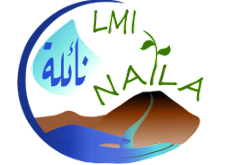Reasearch axis 3 (R3): past trajectories, current situations and future developments
Actions in detail
Action I : Collective reflection workshop: Knowledge production and societal needs
« What is the use of water research in Tunisia today? », LMI Naïla, January 2018.
Conception: Jeanne Riaux, Sylvain Massuel, Marcel Kuper (UMR G-EAU)
Animation : Amar Imache (LISODE)
The objective of this workshop was to think together about our postures as researchers vis-à-vis society and more specifically vis-à-vis the usual partners: technical departments and administrative agents (decision-makers and managers). The starting hypothesis was that the research/society relationship having evolved over the last decades, it was important to have a reflective look at our interlocutors, the nature of our research results and the way in which these results can be disseminated/ shared with water stakeholders.
To this end, a collective reflection workshop was organized in January 2018 as part of the LMI NAÏLA, with researchers from the LMI or relatives.
This workshop lasted 4 days and brought together around twenty researchers selected to have a varied panel of profiles: social sciences and biophysical sciences, French and Tunisian researchers, men and women, academics or in connection with development engineering, researchers seniors or young researchers, etc. Based on a “participatory”
facilitation approach, the researchers present were able to reflect, express themselves and debate on several themes including: the values carried by the researchers, the way in which they communicate with society and the functions of the researchers in society, whether these functions are assigned to them by society or whether these functions are those which the researchers wish to assume.
This workshop highlighted the gap that exists between the functions that researchers wish or think of occupying, whether it is to issue alerts, respond to societal concerns, produce knowledge, etc. and how the research/society partnership is shaped. It seems that the inter research dialogue has a preponderant function both to produce knowledge, but also to objectify the knowledge produced and disseminate it in society. This stage of reflection gives us the basis for returning to society, taking better account of what is meant by “society”, the different functions that research can occupy. Science/society dialogue mechanisms must be thought out in an ad hoc manner according to the type of knowledge to be circulated and the joint objectives of the researcher and his interlocutors in society. The LMI must make it possible to promote this development and to enhance the diversity of forms and results.
Read more
Read more
Action II: Development of 3D calculation methodologies applied to archival aerial images
Denis Feurer (IRD/LISAH) et Sylvain Massuel (IRD/G-EAU)
Read more
| Goals | Old aerial images, with a resolution finer than one meter and dating back to the beginning of the last century, have the potential to document past events. Moreover, the recent computer vision algorithms used in photogrammetry (“SfM” approaches, Structure from Motion) open up, because they are “all-image” approaches, new possibilities for using these images. Indeed, SIFT (Scale Invariant Feature Transform) type algorithms make it possible to automatically detect points in images by associating them with an invariant descriptor with linear transformations (change of scale and rotation). The objective of the action is thus to assess the potential of such data and algorithms for the documentation of past 3D changes. |
| Approach/methodology | The idea of this work starts from the assumption that, for certain spatio-temporal scales, these descriptors can also present an invariance in time. The proposed method, called Time-SIFT, simply consists of carrying out the first steps of the calculation with a set of images of different dates in order to constitute a single geometric reference. Once all the data is in a single geometry, it becomes possible to calculate 3D differences between dates. A multifactorial analysis work was carried out to evaluate the interest of the Time-SIFT method compared to other treatment strategies. |
| Principal results | Studies carried out on images covering an area of 170 km² over a period of more than 40 years have demonstrated that the use of the Time-SIFT method was the first factor of success for the detection of 3D changes. The application of this method has made it possible to highlight 3D changes linked to urban developments, road works, but also sampling and embankments. |
